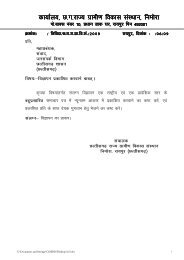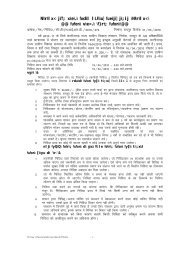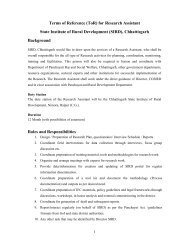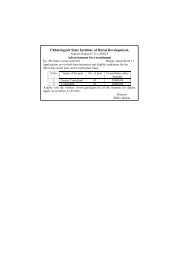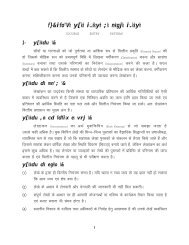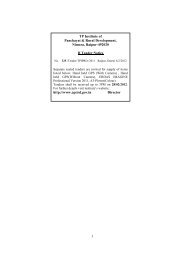Study on Mahua Sub Sector - Cgsird.gov.in
Study on Mahua Sub Sector - Cgsird.gov.in
Study on Mahua Sub Sector - Cgsird.gov.in
You also want an ePaper? Increase the reach of your titles
YUMPU automatically turns print PDFs into web optimized ePapers that Google loves.
2.6 Limitati<strong>on</strong>s<br />
The study is limited to study<strong>in</strong>g the <strong>Mahua</strong> flower sub sector. Another major product of<br />
<strong>Mahua</strong> tree, <strong>Mahua</strong> seed is part of a completely different value cha<strong>in</strong> and hence is not<br />
part of this study. Trade <strong>in</strong> <strong>Mahua</strong> flower is c<strong>on</strong>sidered a very secretive affair and it is<br />
difficult to get reliable data. Various sec<strong>on</strong>dary sources give very different sets of data for<br />
comparable years. The range of variati<strong>on</strong> is as high as 200 per cent. It is neither a<br />
nati<strong>on</strong>alized item nor an excisable item <strong>in</strong> undivided Madhya Pradesh even before PESA<br />
came <strong>in</strong>to force. Hence Govt. departments do not have the <strong>Mahua</strong> flower related data for<br />
the last <strong>on</strong>e and a half decade. Unless it is transported over l<strong>on</strong>ger distances, transit pass<br />
and mandi receipts are not required. In fact the mandi <strong>in</strong> charge told us that barely 5-10<br />
per cent of total producti<strong>on</strong> comes to mandi. Hence the study has to rely <strong>on</strong> primary<br />
sources of data and estimates made <strong>in</strong> studies c<strong>on</strong>ducted earlier.<br />
3. <strong>Sub</strong> sector Map<br />
3.1.1 The producti<strong>on</strong> sub system<br />
<strong>Mahua</strong> trees are found both <strong>in</strong> forest lands and <strong>in</strong> lands owned by the <strong>in</strong>dividuals.<br />
Farmers with more lands are expected to have more number of <strong>Mahua</strong> trees. The practice<br />
is to collect <strong>Mahua</strong> flower from own trees first and then go to the forest for collecti<strong>on</strong>. An<br />
estimated 35pc of the collecti<strong>on</strong> comes from own trees and rest from forests. <strong>Mahua</strong><br />
flower<strong>in</strong>g happens for around 4-6 weeks between March to May. But the period varies<br />
from place to place. Ra<strong>in</strong>s dur<strong>in</strong>g this period affect the crop. The process of collecti<strong>on</strong><br />
starts with clean<strong>in</strong>g of the forest floor <strong>on</strong> the previous day. Next day morn<strong>in</strong>g the women<br />
and children go to the tree/forest forest for collecti<strong>on</strong>. It c<strong>on</strong>t<strong>in</strong>ues from early <strong>in</strong> the<br />
morn<strong>in</strong>g till the sun is right above the head(from 6 am till 1 pm). The effective collecti<strong>on</strong><br />
days per household are 20 days <strong>in</strong> a seas<strong>on</strong>. Collecti<strong>on</strong> is d<strong>on</strong>e by women and children of<br />
the household <strong>in</strong> the baskets, which are hand made out of bamboo. On an average <strong>on</strong>e<br />
family member manages to collect 10-15 kgs (1=Gapa=1Basket) of <strong>Mahua</strong> <strong>in</strong> a day.<br />
Collecti<strong>on</strong> from <strong>on</strong>e <strong>Mahua</strong> tree varies from 1.5 to 3qu<strong>in</strong>tals depend<strong>in</strong>g up<strong>on</strong> the age and<br />
the girth of the tree.<br />
An average sized tree yields about 50 – 100 kg of flower <strong>in</strong> a seas<strong>on</strong> that lasts around a<br />
m<strong>on</strong>th. It is said that low ra<strong>in</strong>fall <strong>in</strong> previous year adversely affects flower producti<strong>on</strong>.<br />
One <strong>Mahua</strong> tree has an annual average yield of 62.5 kg of flower and 59 kg of gully as<br />
per <strong>on</strong>e study. Another study d<strong>on</strong>e by SFRI, Jabalpur f<strong>in</strong>ds that yield per tree varies<br />
between 11.43 to 76.8 Kg a year.



![kjsyky iapk;r ,oa xzkeh.k fodkl laLFkku]fueksjk] jk;iqj - Cgsird.gov.in](https://img.yumpu.com/43287415/1/184x260/kjsyky-iapkr-oa-xzkehk-fodkl-lalfkkufueksjk-jkiqj-cgsirdgovin.jpg?quality=85)

